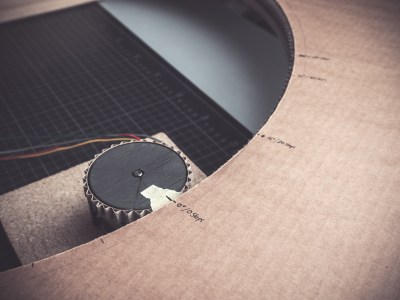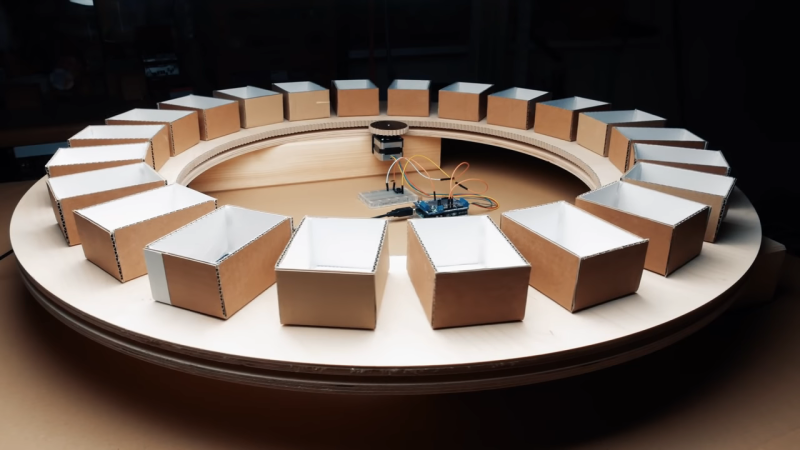If you collect trading cards of any kind, you know that storage quickly becomes an issue. Just ask [theguymasamato]. He used to be really into trading cards, and got back into it when his kids caught the bug. Now he’s sitting on 10,000+ cards that are largely unorganized except for a few that made it into sleeve pages. They tried to go through them by hand, but only ended up frustrated and overwhelmed. Then he found out about [Michael Portera]’s Pi-powered LEGO card sorter and got all fired up to build a three-part system that feeds cards in one by one, scans them, and sorts them into one of 22 meticulously-constructed cardboard boxes.
 [theguymasamato]’s card sorter is the last stop for a card after the feeder has fed it in from the pile and the scanner has scanned it. The sorter lazy Susans around on a thrust bearing, which is driven by a 3D printed drive wheel attached to a stepper. The stepper is controlled with an Arduino.
[theguymasamato]’s card sorter is the last stop for a card after the feeder has fed it in from the pile and the scanner has scanned it. The sorter lazy Susans around on a thrust bearing, which is driven by a 3D printed drive wheel attached to a stepper. The stepper is controlled with an Arduino.
Here’s where it gets crazy: the drive wheel and timing belt are made from the flutes of corrugated cardboard. As in, he used that wavy bit in the middle as gear teeth. Every one of those cardboard teeth is fortified with wood glue, a time-consuming process he vows to never repeat. Instead, [theguymasamato] recommends using shims to shore them up as he did in the card feeder. The whole thing was originally going to be made from cardboard. It proved to be too mushy to support the thrust bearing, so [theguymasamato] switched to MDF.
Right now, the sorter is homed via button press, but future plans for the device include an IR break beam switch. We’re excited for the scanner and can’t wait to see the whole system put together. While [theguymasamato] works on that, position yourself past the break to watch the build video.

















Just the wheel by itself pushed against the wood by a spring (friction) and a magnet glued to each position to sense the stopping points (or refective tape, or any type of sensor). One position has two magnets, so the processor knows its “home position” if things get lost. It can spin fast either direction to find the ‘home position’, and then spin slower in either direction to count to the proper locations, always keeping track of which sensor it is on.
Or a QR code on each box and a bar code reader scanning them, stopping at the correct box. More expensive though.
Just love this project. Even down to filling the drive wheel ‘corrugations’ with glue, to reinforce them!
This is such an incredible waste of time and energy.
It looks like some “art” piece, with an “artsy” video.
These cardboard gears simply do not work and are going to fall apart in less time than it took to painstakingly glue the thing together.
Friction wheels have been used for ages and work reliably, from small rubber wheels to standard car wheels.
And as noted before position sensing can also be easily done nowaday’s in multiple different ways.
To paraphrase one of Heinlein’s characters – critics are unbiased – they hate all creative people equally
You may have noticed Heinlein was an SF writer?
I like quite a lot of projects posted on Hackaday, that’s why I come back here.
Well I doubt if criticism on this project is of any use. Despite the fact that Paul has some very strong points, the use of cardboard is the whole reason for the project, the goal is to make something move while using cardboard at critical locations, it has to be art and to be honest… the project itself doesn’t even look practical to begin with. So who cares how it is made?
But using cardboard is refreshing, it is nice to see people using materials that are highly underrated for their task yet gracefully accomplish the goal, I love it! Thinking out of the box (pun intended).
Dude, if you just click to the site, it says:
“There are many ways to do it.
It was important to me:
* as few mechanical and electrical parts as possible
* to use gravity
* cool look
* a lot of movement
* visible movement
It was NOT important to me:
* space saving, lightweight, portable
* effective or fast”
In other words, he set goals and achieved them. No skin off his back if they don’t match whatever your arbitrary goals are.
To be fair, “effective” isn’t usually seen as an arbitrary goal.
I wouldn’t call this a card sorter by any means, it may eventually be part of one, but not this thing alone. It’s just a big lazy suzan driven by a stepper and arduino…
Yes this is part of one (a series on how to build it). The card feeder is here: https://www.instructables.com/id/Card-Feeder-for-a-Trading-Card-Machine/
The scanner is coming up in a later update.
I like the way the servo motor is on an inside ring. I think I am going to have to consider using this design for the turret/azimuth controller for the passive synthetic aperture radar mount build. Thinking I can keep more electronics out of adverse weather conditions this way also. Especially if I use a conductive ring maybe with house wiring in a groove and fingers to make a rotor.
I’d have used an IR photo eye to detect the slots between the boxes and block one of the slots to act as the home slot. Simpler than this, cheaper, and quicker to implement. If you wanted to be colorful a color sensor would probably work also or a plain photo eye with white black pattern on the inside of the wheel.